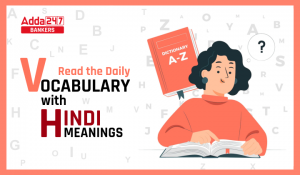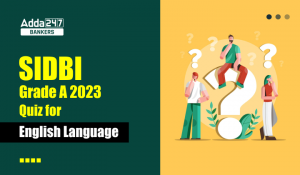This section can be easy as pie if your basics are clear. Sometimes, even those who can communicate very well in English, fail to perform to the best of their ability in the banking exams. So, instead of boiling the ocean, try building up a strong vocabulary, an effective knowledge of grammar, and efficient comprehension skills so as to be on the ball to face this particular section. Here is a quiz being provided by Adda247 to let you practice the best of latest pattern English Questions.
Dear Aspirants,
Directions (Q1- 7): Read the following passage carefully and answer the questions given below it. Certain words/phrases are printed in bold to help you locate them while answering some of the questions.
The early Orientalist movement and the rapid growth of English as the principal medium of instruction after the 1830s, considerably enhanced the educated Indian’s familiarity with his tradition. But, perhaps equally importantly, it also fostered a sense of shared culture. Ram Mohan may have been the first Hindu to have used the term ‘Hinduism’, thereby indicating some degree of culture or perhaps even ethnic essentialization. These developments were also facilitated by the coming of the printing press. Over time, the success of print-culture enormously increased the importance of written texts within a tradition that had hitherto greatly relied on orality. Perhaps this strengthened the hands of some writers who, particularly towards the end of the nineteenth century, began to emphasize a common cultural base for Hinduism. In the religious sphere, for example, there was now a far greater emphasis on the Vedas as a unified source of Hinduism, the ‘prime determinant of a ‘Hindu’ identity.
The success of the printing press is also tied up with certain extremely important shifts that began to occur in the social and religious thinking of early nineteenth century Bengal. Hitherto, texts considered to be the most important in Hinduism had been zealously guarded by a class of Brahmins which prevented their wider circulation. Women and Sudras, for example, had traditionally been barred from Vedic knowledge. More importantly, these Hindu scriptures were composed in ‘ Sanskrit which meant that many other social groups besides women and Sudras had practically no access to the Vedas. Early reformers like Ram Mohan addressed these issues simultaneously. On the one hand, Ram Mohan bravely went against tradition by attempting to open up Vedic knowledge to all those who might be moved to seek it, irrespective of their social origin. This was the impulse behind his publication of Bengali translations of Hindu religious classics like the Vedanta Sutra (Brahma Sutra), and subsequently, some important Upanishads. This is also precisely why Ram Mohan became such a controversial figure.
Q1. Why did Ram Mohan become a controversial figure?
(a) He created awareness and sensitivity about our cultural heritage.
(b) He advocated that patriotism is a natural instinct among People
(c) He advocated that racial identity is crucial for political independence
(d) He opposed the move of opening the first Sanskrit college in Bengal
(e) He opened up the knowledge of Vedas to all the sections of the society
Q2. Which of the following factors contributed to the enhancement of educated Indian’s familiarity with his tradition?
(a) Critical reappraisal of the sources of his knowledge about tradition
(b) The early criticism and negation of the Orientalist movement
(c) Awareness about the true spirit of Hinduism
(d) The rapid growth of English as the main medium of instruction
(e) Realization of the importance and acquisition of Hindu identity
Q3. Which of the following important shifts is the author of the passage talking about in the early 19th Century Bengal?
(a) Emphasizing the common culture base for Hinduism
(b) Fostering a sense of shared culture
(c) Studying carefully the religious classics like Vedanta Sutra and Upanishads
(d) Social and religious thinking of the people
(e) Political and economic thinking of the people
Q4. Why were the important texts of Hinduism not widely circulated?
(a) They were not easily available and cheaply priced
(b) People were not aware of the true knowledge contained in these texts
(c) They were ardently protected by the religious priests and preachers
(d) Orthodox thinking was more dominant than the rational thinking
(e) Ethics essentialisation was gravely missing among the people
Q5. The early Orientalist movement and English as the medium of instruction…
(a) Provided tacit but strong support to the liberation movement
(b) Increased understanding and awareness of the Indian education system
(c) Developed a sense of shared culture among the Indians
(d) Made Indians adequately emotional and nostalgic
(e) Encouraged students to obtain admissions in English medium educational institutions
Q6. Which of the following strengthened the hands of some writers towards the end of the 19th Century?
(a) Ram Mohan’s use of the term ‘Hinduism’ for the first time
(b) Advent of the printing press and realisation of the importance of written texts
(c) Ram Mohan’s insistence on the study of Indian texts and traditions
(d) Opening of Vedic knowledge to all the sections of the society
(e) Interference of the foreigners in the Indian cultural tradition
Q7. Choose the word which is SIMILAR in meaning of the word “fostered” as used in the passage.
(a) Promoted
(b) Appreciated
(c) Widened
(d) Aligned
(e) Involved
Q8. Choose the word which is MOST OPPOSITE in meaning of the word “moved’ as used in the passage.
(a) Deterred
(b) Obliged
(c) Abandoned
(d) Motivated
(e) Adhered
Directions (09-10): In the question given below few sentences are given which are grammatically correct and meaningful. Connect them by the word/phrase given above the statements in the best possible way without changing the intended meaning. Choose the best possible combination as your answer accordingly from the options to form a correct, coherent sentence.
Q9. Whether
(A) As banks sharpen their internal assessment of risk before lending, they are investing in analytics, data gathering and use of social media more now than on conventional tools like score from credit information bureaus, which capture borrowing behaviour.
(B) To sanction a loan for you to buy a home or car, rather than relying solely on your credit card repayments.
(C) It is not just Kotak but others too, such as HDFC Bank, Axis Bank and even state-owned banks like State Bank of India, which use social media behaviour not only for loan sanctions but also for tailoring sales pitch for products.
(D) Loan officers at Kotak Mahindra Bank are spending more time in reading your Facebook posts, SMSes and payment data available in your mobile phone to decide.
(a) Only B-A
(b) Only D-B
(c) Only D-C
(d) Only A-C
(e) None
Q10. Also
(A) These mutations turn good cells bad by boosting the expression of a protein called PD-L1, or programmed death-ligand 1.
(B) Mutations in the Ras gene are double trouble.
(C) PD-L1 is being targeted by cancer immunotherapies, which try to unmask cancer cells, much about PD-L1 remains unknown
(D) Mutations help bad cells masquerade as good cells by uplifting protein PD-L1.
(a) Only A-B
(b) Only C-D
(c) Only B-C
(d) Only A-D
(e) None
Directions (11-15): Each of the following questions has a paragraph from which one sentence has been deleted. From the given options, choose the one that completes the paragraph in the most appropriate way.
Q11. The Great Bolshevik Revolution of October 1917 was by no means simply a “Russian” revolution. Rather, it was a watershed event and a turning point in universal human history. This revolution came after a whole chain of revolutions that broke out in Europe in the aftermath of the French Revolution of 1789, but it was the first that envisioned the end not only of the rule of capital but of private property altogether, thus of all class society as such. In his seminal writings of March-April 1917, Lenin in fact envisions an immediate “withering away of the state”. ___________________________________________.
(a) The Bolshevik Revolution was the great historic event with which the peasantry first emerged as the maker of its own history.
(b) Russian colonies were the first in history to make a direct transition from colonial subjection to socialist liberation.
(c) Unlike Britain or France, Russia was not strong enough to acquire colonies far from its frontiers.
(d) This was the most far-reaching project that any revolution had ever set for itself.
(e) Russia itself was not only a tsarist state.
Q12. The October Revolutionised the conception of a “revolution”. In a sense, all revolutions do that anyway, but the October Revolution did so in a manner that continues to have an abiding relevance. Marx and Engels had essentially visualised a proletarian revolution in Europe. Engels, in his famous letter to Karl Kautsky in 1882, had talked no doubt of the possibility of revolutions in countries such as India, Egypt and Algeria, adding that “that would certainly be the best thing for us” (that is, for the proletarian revolution in Europe), but how such revolutions in the “periphery” might unfold and, in particular, how they were related to the prospects of socialism in those countries was not theorised. _______________________________________________________.
(a) This meant that the task of carrying forward the democratic revolution in such countries fell on the working class, which had to form an alliance with the peasantry for this purpose.
(b) The focus had been on socialist revolution in Europe.
(c) The theoretical work preceding and underlying the October Revolution broke new ground.
(d) Centralisation of capital in each of the advanced capitalist countries had reached a point, in the spheres of both industry and banking, where a small financial oligarchy presided over a huge mass of finance capital that was controlled by banks and employed in industry.
(e) This theory was further developed by its integration with the understanding of imperialism that came with the First World War.
Q13. It was a hectic two weeks for the Saudi Crown Prince, Mohammed bin Salman, or MBS as he is now popularly known. In the first fortnight of November, the de facto ruler of the Kingdom of Saudi Arabia initiated a purge that involved the arrest of some of his royal half-brothers, leading businessmen, artistes and media professionals. He then announced a full blockade on Yemen after a missile fired from that country fell perilously close to the international airport in Riyadh, the Saudi capital. _____________________________________________________. The Prime Minister of Lebanon, Saad Hariri, was urgently summoned to Riyadh by the Saudi King. According to reports, he was promptly arrested after landing and given a prepared speech of resignation to read.
(a) The State Department memo detailing the conversation between Prince Alwaleed and the American ambassador was released by WikiLeaks.
(b) The Lebanese President has said that the Saudi authorities are holding the Prime Minister against his will.
(c) Hariri, before his unannounced appearance on a Saudi television channel, was presiding over a Lebanese government that was, after a long time, working in a united and cohesive way.
(d) After that he did something unparalleled in the history of contemporary diplomacy or politics in the region.
(e) The Lebanese Prime Minister was ordered to come alone to Riyadh by the Saudi authorities.
Q14. About two years ago when Dr A.P.J. Abdul Kalam breathed his last, the National Democratic Alliance (NDA) government decided to live up to tradition in paying tribute to the former President. Kalam, who was famously called a “nationalist despite being a Muslim” by a Union Minister, had a road named after him in the heart of Lutyens’ Delhi. There was a catch, though: Aurangzeb Road was renamed A.P.J. Abdul Kalam Road. It was the latest instance of the time-worn “Good Muslim/Bad Muslim” binary, the liberal, nationalist Muslim versus a bigot. A few eyebrows were raised, but nobody complained. _____________________________________________________.
(a) Aurangzeb has always been criticised, projected as a villain who did nothing right.
(b) He was a pioneer in the development and use of Mysore rockets in warfare.
(c) The objective is to create antipathy towards Muslim rulers
(d) There are no good Muslims left, at least in history.
(e) Kalam deserved to be remembered by posterity.
Q15. State Bank of India is the only Indian bank to figure in the list of the world’s top 50 banks and the only one to be listed in Fortune 500. It is widely known as the banker of the nation and has 23,566 branches in the country, of which 15,037 are in rural and semi-urban areas. SBI has 189 international offices in 35 countries. __________________________________________________. It recently acquired additional muscle by merging its five associate banks with itself, besides opening crores of new accounts under the Prime Minister’s Jan Dhan Yojana. This bank is now being gifted to Reliance Industries Limited (RIL) on a platter, ostensibly for the purpose of “banking the unbanked”.
(a) The Reserve Bank of India (RBI) gave its final approval to RIL to start its payment bank in March 2017.
(b) Is it the beginning of the end for State Bank of India (SBI)?
(c) The avowed objective of the government and the RBI in giving the approval to the RIL-SBI partnership was to utilise the latest technology of Reliance Jio to reach unbanked rural areas.
(d) According to SBI officers, business correspondents appointed by SBI are being asked to work for RIL, thereby giving the corporate house an established network of business correspondents.
(e) As of September 30, 2014, the bank had approximately 225 million active customer accounts, and deposits, net advances and a total assets base of Rs.14,73,785 crore, Rs.12,09,648 crore and Rs.18,74,332 crore respectively.
You May also like to Read:




 Daily Vocabulary Word 28th April, 2023 -...
Daily Vocabulary Word 28th April, 2023 -...
 English Quizzes For SIDBI GRADE A 2023- ...
English Quizzes For SIDBI GRADE A 2023- ...








